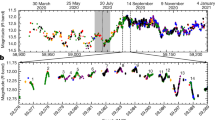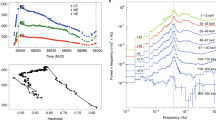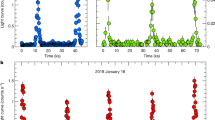Abstract
In September 2017, the IceCube Neutrino Observatory recorded a very-high-energy neutrino in directional coincidence with a blazar in an unusually bright gamma-ray state, TXS0506 + 056 (refs1,2). Blazars are prominent photon sources in the Universe because they harbour a relativistic jet whose radiation is strongly collimated and amplified. High-energy atomic nuclei known as cosmic rays can produce neutrinos; thus, the recent detection may help in identifying the sources of the diffuse neutrino flux3 and the energetic cosmic rays. Here we report a self-consistent analysis of the physical relation between the observed neutrino and the blazar, in particular the time evolution and spectral behaviour of neutrino and photon emission. We demonstrate that a moderate enhancement in the number of cosmic rays during the flare can yield a very strong increase in the neutrino flux, which is limited by co-produced hard X-rays and teraelectronvolt gamma rays. We also test typical radiation models4,5 for compatibility and identify several model classes6,7 as incompatible with the observations. We investigate to what degree the findings can be generalized to the entire population of blazars, determine the relation between their output in photons, neutrinos and cosmic rays, and suggest how to optimize the strategy of future observations.
This is a preview of subscription content, access via your institution
Access options
Access Nature and 54 other Nature Portfolio journals
Get Nature+, our best-value online-access subscription
$29.99 / 30 days
cancel any time
Subscribe to this journal
Receive 12 digital issues and online access to articles
$119.00 per year
only $9.92 per issue
Buy this article
- Purchase on Springer Link
- Instant access to full article PDF
Prices may be subject to local taxes which are calculated during checkout




Similar content being viewed by others
Data availability
The historical observations analysed during the current study are available in the SED Builder Tool of the Space Science Data Center (SSDC) and from the NASA/IPAC Extragalactic Database (NED). The data that support the plots within this paper and other findings of this study are available from S.G. and A.F. upon reasonable request.
References
Blaufuss, E. IceCube-170922A—Icecube Observation of a High-Energy Neutrino Candidate Event GCN Circular 21916 (2017).
Aartsen, M. et al. Multimessenger observations of a flaring blazar coincident with high-energy neutrino IceCube-170922a. Science 361, eaat1378 (2018).
Aartsen, M. et al. Observation and characterization of a cosmic muon neutrino flux from the northern hemisphere using six years of IceCube data. Astrophys. J. 833, 3 (2016).
Urry, C. M. & Padovani, P. Unified schemes for radio-loud active galactic nuclei. Publ. Astron. Soc. Pacif. 107, 803 (1995).
Böttcher, M., Reimer, A., Sweeney, K. & Prakash, A. Leptonic and hadronic modeling of Fermi-detected blazars. Astrophys. J. 768, 54 (2013).
Mannheim, K. & Biermann, P. L. Gamma-ray flaring of 3C 279—a proton-initiated cascade in the jet? Astron. Astrophys. 253, L21–L24 (1992).
Mücke, A. & Protheroe, R. J. A proton synchrotron blazar model for flaring in Markarian 501. Astropart. Phys. 15, 121–136 (2001).
Mücke, A., Engel, R., Rachen, J. P., Protheroe, R. J. & Stanev, T. SOPHIA: Monte Carlo simulations of photohadronic processes in astrophysics. Comput. Phys. Commun. 124, 290–314 (2000).
Hümmer, S., Rüger, M., Spanier, F. & Winter, W. Simplified models for photohadronic interactions in cosmic accelerators. Astrophys. J. 721, 630–652 (2010).
Kadler, M. et al. Coincidence of a high-fluence blazar outburst with a PeV-energy neutrino event. Nat. Phys. 12, 807–814 (2016).
Gao, S., Pohl, M. & Winter, W. On the direct correlation between gamma-rays and PeV neutrinos from blazars. Astrophys. J. 843, 109 (2017).
Petropoulou, M., Dimitrakoudis, S., Padovani, P., Mastichiadis, A. & Resconi, E. Photohadronic origin of γ-ray BL Lac emission: implications for IceCube neutrinos. Mon. Not. R. Astron. Soc. 448, 2412–2429 (2015).
Cerruti, M., Zech, A., Boisson, C. & Inoue, S. A hadronic origin for ultra-high-frequency-peaked BL Lac objects. Mon. Not. R. Astron. Soc. 448, 910–927 (2015).
Sadowski, A. & Narayan, R. Powerful radiative jets in supercritical accretion discs around non-spinning black holes. Mon. Not. R. Astron. Soc. 453, 3213–3221 (2015).
van Marle, A. J., Casse, F. & Marcowith, A. On magnetic field amplification and particle acceleration near non-relativistic astrophysical shocks: particles in MHD cells simulations. Mon. Not. R. Astron. Soc. 473, 3394–3409 (2018).
Cerruti, M., Zech, A., Emery, G. & Guarin, D. Hadronic modeling of TeV AGN: gammas and neutrinos. AIP Conf. Proc. 1792, 050027 (2017).
Krawczynski, H. et al. Multiwavelength observations of strong flares from the TeV blazar 1ES 1959+650. Astrophys. J. 601, 151–164 (2004).
Archambault, S. et al. Deep broadband observations of the distant gamma-ray blazar PKS 1424+240. Astrophys. J. Lett. 785, L16 (2014).
Sánchez-Conde, M. A., Paneque, D., Bloom, E., Prada, F. & Domnguez, A. Hints of the existence of axionlike particles from the gamma-ray spectra of cosmological sources. Phys. Rev. D 79, 123511 (2009).
Essey, W. & Kusenko, A. A new interpretation of the gamma-ray observations of distant active galactic nuclei. Astropart. Phys. 33, 81–85 (2010).
Abeysekara, A. U. et al. VERITAS observations of the BL Lac object TXS 0506+056. Astrophys. J. Lett. 861, L20 (2018).
Aartsen, M. G. et al. All-sky search for time-integrated neutrino emission from astrophysical sources with 7 yr of IceCube data. Astrophys. J. 835, 151 (2017).
Abdollahi, S. et al. The second catalog of flaring gamma-ray sources from the Fermi All-sky Variability Analysis. Astrophys. J. 846, 34 (2017).
Chen, X., Pohl, M. & Böttcher, M. Particle diffusion and localized acceleration in inhomogeneous AGN jets—I. Steady-state spectra. Mon. Not. R. Astron. Soc. 447, 530–544 (2015).
Chen, X., Pohl, M., Böttcher, M. & Gao, S. Particle diffusion and localized acceleration in inhomogeneous AGN jets—II. Stochastic variation. Mon. Not. R. Astron. Soc. 458, 3260–3271 (2016).
Paiano, S., Falomo, R., Treves, A. & Scarpa, R. The redshift of the BL Lac object TXS 0506+056. Astrophys. J. 854, L32 (2018).
Aartsen, M. G. et al. A search for neutrino emission from fast radio bursts with six years of IceCube data. Astrophys. J. 857, 117 (2018).
Fedynitch, A., Engel, R., Gaisser, T. K., Riehn, F. & Stanev, T. Calculation of conventional and prompt lepton fluxes at very high energy. EPJ Web Conf. 99, 08001 (2015).
Dembinski, H. P. et al. Data-driven model of the cosmic-ray flux and mass composition from 10 GeV to 1011 GeV. PoS ICRC2017, 533 (2017).
Riehn, F. et al. The hadronic interaction model SIBYLL 2.3c and Feynman scaling. In 35th International Cosmic Ray Conference (ICRC2017) https://doi.org/10.22323/1.301.0301 (Proceedings of Science, 2017).
Palladino, A. & Winter, W. A multi-component model for the observed astrophysical neutrinos. Astron. Astrophys. 615, A168 (2018).
Inoue, Y. et al. Extragalactic background light from hierarchical galaxy formation: gamma-ray attenuation up to the epoch of cosmic reionization and the first stars. Astrophys. J. 768, 197 (2013).
Acknowledgements
We thank A. Taylor, A. Palladino and E. Bernardini for discussions and comments. S.G., A.F. and W.W. have received funding from the European Research Council (ERC) under the European Union’s Horizon 2020 research and innovation programme (grant no. 646623).
Author information
Authors and Affiliations
Contributions
S.G. performed the numerical modelling and created the artwork. A.F. extracted and analysed the data. S.G. and A.F. provided first technical documentation. All authors contributed to development of the theoretical ideas and interpretation of the results. The final manuscript was written by M.P., W.W. and A.F. with contributions from S.G.
Corresponding author
Ethics declarations
Competing interests
The authors declare no competing interests.
Additional information
Publisher’s note: Springer Nature remains neutral with regard to jurisdictional claims in published maps and institutional affiliations.
Supplementary information
Supplementary Information
Supplementary Figures 1–4, Supplementary Table 1, Supplementary References 1–5
Rights and permissions
About this article
Cite this article
Gao, S., Fedynitch, A., Winter, W. et al. Modelling the coincident observation of a high-energy neutrino and a bright blazar flare. Nat Astron 3, 88–92 (2019). https://doi.org/10.1038/s41550-018-0610-1
Received:
Accepted:
Published:
Issue Date:
DOI: https://doi.org/10.1038/s41550-018-0610-1
This article is cited by
-
Multiwavelength Properties of Selected High Redshift Blazars
Astrophysics (2023)
-
High-energy neutrino transients and the future of multi-messenger astronomy
Nature Reviews Physics (2022)
-
BL Lac object OJ 287: exploring a complete spectrum of issues concerning relativistic jets and accretion
Journal of Astrophysics and Astronomy (2022)
-
Multiwavelength Monitoring of Blazars PKS 2155-304 and S5 0716+71
Astrophysics (2022)
-
Athena synergies in the multi-messenger and transient universe
Experimental Astronomy (2022)



